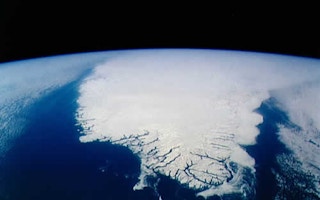A report from an international scientific team due next month will probably focus on a range of evidence that the Earth is warming rather than just changes in air temperature, according to a climate scientist who has seen drafts of parts of the study.
The rate of polar ice melting, warming of oceans and the steady rise of sea levels all point to a planet heating up, said Kevin Trenberth, a senior scientist in the climate analysis section at the National Center for Atmospheric Research. He’s a reviewer for the forthcoming United Nations climate report.
Some skeptics of man’s contribution to global warming have pointed to lapses in the rise of average temperatures as proof that the phenomenon isn’t taking place. Previous studies focused on changes in air temperature, according to Trenberth, who was the lead author of the 2001 and 2007 UN assessments.
“There are other signs of warming that are abundantly clear,” Trenberth said in an interview. “Those are some of the messages that I think might end up coming out of this report. It’s really strong in areas other than just the global mean temperature or even regional temperatures around the world.”
A draft of a summary of the report for policy makers predicts that sea levels may rise as much as 3 feet (0.9 meters) by 2100, according to Trenberth.
Melting ice
“There’s a 5 percent chance that it might get to that level if something unusual happens and a big chunk of the ice sheet actually collapses into the ocean and therefore melts quite a bit faster than it otherwise would,” Trenberth said.
Actual sea level rise by 2100 is likely to be somewhere between 10 inches and 3 feet, he said.
“Sea level is going to keep rising even if we stabilize other aspects of the climate system,” he said.
The report is being prepared by the Intergovernmental Panel on Climate Change, an international group of scientists appointed by the UN. The group, which does no original research, periodically summarizes published literature on the subject.
In the 2007 report, scientists put the chances that human activity was warming the planet at 90 percent. The next one is likely to raise that figure.
“It’s a fairly minor change, one that was not unexpected,” Trenberth said.
‘Intermediate products’
Text in the draft probably will change in response to government comments and discussion at a four-day meeting in late September, the UN panel said yesterday in an e-mailed statement.
“Draft reports are intermediate products and should not be represented as the final scientific view that the IPCC provides to policymakers in its finalized and accepted report,” according to the statement.
A total of more than 830 authors and editors from 85 nations are compiling the IPCC’s so-called fifth assessment report. The terms used are assigned probabilities, with “virtually certain” representing 99 percent to 100 percent; extremely likely being at least 95 percent; “very likely” is 90 percent and up; and “likely” is at least 66 percent.
‘Predetermined science’
“This is predetermined science,” Marc Morano, executive editor of Climate Depot, a blog that posts articles skeptical of climate change, said in an interview. “There’s going to be a collective yawn from most of the world when this report comes out. Ultimately, this report is going to add very little to the scientific debate.”
In 2007, the IPCC said global warming is an unequivocal fact and that “most of the observed increases in globally-averaged temperatures since the mid-20th century is very likely due to the observed increase in anthropogenic greenhouse gas concentrations.”
Last month, researchers in five nations reported that sea levels may rise by more than 2 meters for each degree Celsius of global warming the planet experiences over the next 2,000 years. The research, published in the Proceedings of the National Academy of Sciences, attempts to iron out the impact of short-term fluctuations in sea levels, examining changes over a longer term for which forecasts are more certain.
Scientific understanding of sea level rise has improved since the 2007 report, according to Trenberth.
“There really wasn’t very much relating to the behavior or the changes in the big ice sheets,” Trenberth said. “I don’t know that the community has got a really good handle on the odds of a big chunk breaking off.”
Temperatures already have climbed about 0.8 degree Celsius and seas have risen about 17 centimeters (7 inches) since the industrial revolution, according to the UN. When temperature gains reach 1 degree, the world will be committed to sea levels about 2.3 meters higher over two millennia, according to the study in the journal of the Washington-based National Academy of Sciences.










